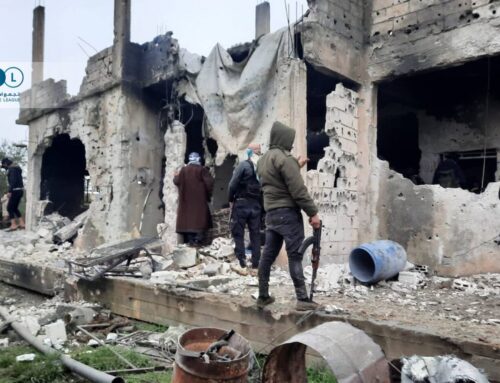One day after purported chlorine-gas bombing, ‘daily’ Aleppo airstrikes kill 22
On Monday Ahrar a-Sham attempted to storm al-Ameria, a regime-held […]
7 September 2016
On Monday Ahrar a-Sham attempted to storm al-Ameria, a regime-held district in west Aleppo, in order to break through the encirclement of Aleppo, by detonating a massive car bomb.
The next day, images of Aleppo city children one kilometer away gasping for air and clutching oxygen masks appeared across the international media. A regime helicopter had reportedly just dropped a barrel bomb containing internationally banned chlorine gas, which killed one resident and left 80 more people struggling to breathe.
The bombs fell on Aleppo’s Sukari district, adjacent to al-Ameria. Sukari is located on the frontline, just east of the Ramouseh neighborhood which regime forces took back on Sunday after one month in rebel hands.
The road connecting east Aleppo city to the rebel-held provincial countryside passes through Sukari. In recent days, Sukari, mainly controlled by Ahrar a-Sham, has been bombed by air even more than usual.
“Over the past few days, bombing has become a daily occurrence,” Ibrahim Abu al-Layth, the Aleppo Civil Defense’s spokesman, tells Syria Direct’s Mohammed al-Haj Ali. “At minimum, that means five airstrikes a day.”
While images of children struggling to breathe capture the world’s attention for a day, 22 east Aleppans were killed in a series of airstrikes on Wednesday alone.
“It’s impossible to describe just how bad things have gotten.”
Q: Have you noticed a ramp-up in the number of attacks on Sukari in recent days?
Over the past few days, bombing has become a daily occurrence. At minimum, that means five airstrikes a day. Wednesday, however, there were seven airstrikes in a span of just 30 minutes, which killed 22 people and injured about another 50 more. The district has been getting pummeled in this recent wave of bombing.

Q: Why is this the case? Why Sukari? What is its strategic significance?
Sukari is certainly one of Aleppo city’s most important districts. It’s what connects the provincial capital to the neighboring countryside, and the only road leading out of the city passes through Sukari. It is also one of east Aleppo’s largest districts, both in terms of size and population density.
Q: Walk us through your work day on Tuesday. How did the Civil Defense respond when they heard reports that barrel bombs had fallen on Aleppo’s Sukari district?
At 1:30 Tuesday afternoon, there was a helicopter and three warplanes in the air. They were bombing two Aleppo city districts—al-Ameria and Sukari—and we were headed to al-Ameria to carry out first response duties. At that point, we suddenly heard reports that a barrel bomb containing chlorine gas had fallen on Sukari.
Immediately, we headed in that direction, and the scene can be described as nothing short of total panic. It was chaos; people were suffocating. We were doing everything in our power to work with the medical personnel on the scene to get the victims into ambulances and cars.
The barrel bomb that had fallen contained these cylinders which were loaded with chlorine gas. The odor was piercing, and everyone was feeling the effects—even the children—and this all took place in what is entirely a residential area.
Aleppo Civil Defense respond to Tuesday’s reported chlorine gas attack. Video courtesy of the Syrian Civil Defense.
Q: On Wednesday, 24 hours after the attack, what is the atmosphere like in Sukari?
Abject fear. Yesterday it was chlorine gas, and today it was a combination of vacuum missiles and cluster bombs. It’s impossible to describe just how bad things have gotten. You have to watch the videos that have been uploaded online to be able to even remotely understand.
Q: If in fact this was chlorine gas, how do you protect yourself in the midst of your rescue operations?
We were caught totally off-guard when we heard about the attack. When we rushed to the scene, we were not properly equipped. In turn, as we got closer, we started to feel the effects of the gas—namely shortness of breath—and so we took shelter in a bathroom. In truth, we never could have imagined this number of injuries.







